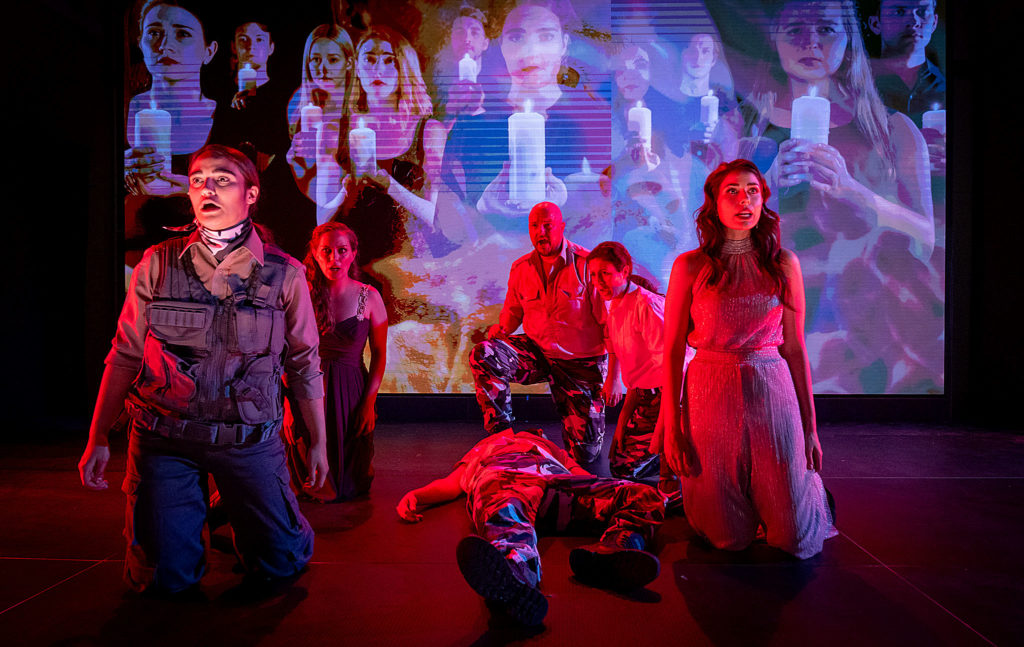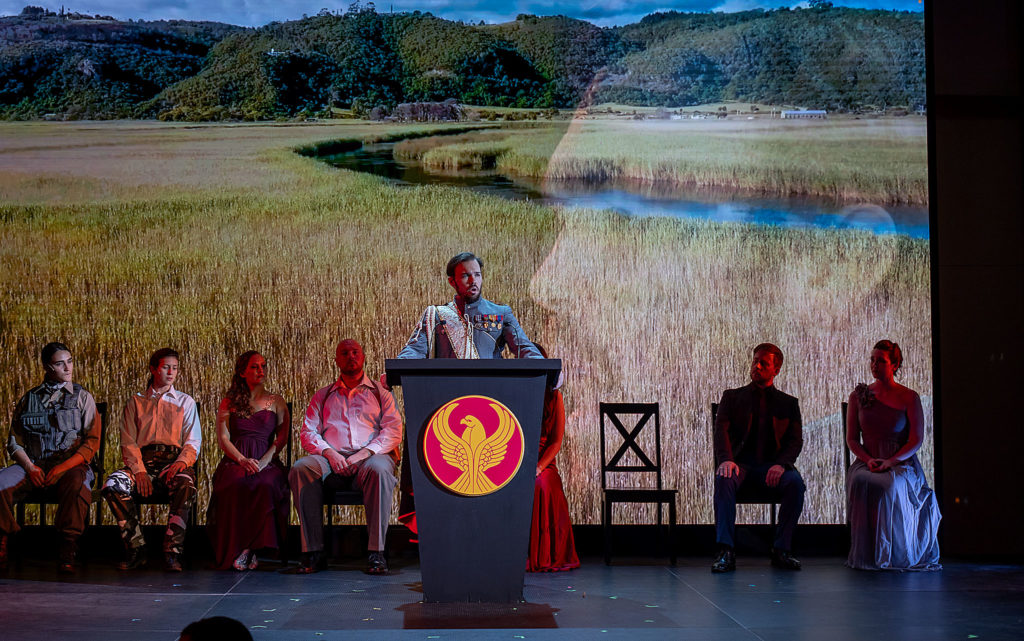Opera Neo Stages ‘Mitridate’ — a Surprisingly Accomplished Work by Mozart at Age 14
Although every biographical account of Mozart acclaims him as one of the greatest prodigies of western music, the operas from Mozart’s youth remain a mystery. Perhaps the mastery and universal appeal of his mature operas, especially Don Giovanni, The Marriage of Figaro and The Magic Flute, have consigned his early operas to obscurity, but the enterprising San Diego company Opera Neo has proven their neglect is unwarranted.
Last summer Opera Neo staged an engaging production of La finta giardiniera, a clever opera buffa Mozart completed at age 18, and this weekend at UC San Diego Park & Market, Opera Neo produced Mitridate, a virtuosic serious dramatic opera Mozart turned out at age 14.

(l. to r.) Darya Narymanava, Emily Helenbrook, Keith Wehmeier, Charles Calotta (prone), Sara Womble & Öznur Tülüoglu [photo (c.) Gary Payne]
Although the opera’s namesake is an historical figure, the drama itself—a clash of sibling rivalry between the king’s sons Sifare and Farnace over their affections towards Mitridate’s latest bride-to-be Aspasia—is pure fiction. The opera’s dramatic fireworks are launched when the king, who was presumed to have been killed in a distant battle, returns alive and well only to discover the unexpected romantic triangle.
Company Artistic Director Peter Kozma assembled a strong cast for this demanding opera seria, including several several leading singers from previous Opera Neo seasons. Öznur Tülüoglu, who brought such panache to the title role of last season’s title role in Mozart’s La finta giardiniera, soared as Aspasia, her sleek, supple soprano unleashing gleaming coloratura pyrotechnics that established the nobility of this queen-in-waiting. In Opera Neo’s 2020-2021 production of Mozart’s Die Zauberflöte, soprano Sara Womble’s Pamina impressed greatly, and her trouser role as Sifare proved vocally and dramatically compelling. In the extended second-act duet between Tülüoglu and Womble, imprisoned together by the king when he learns of their mutual love, their beautifully matched voices could not have been more scintillating.
In Opera Neo’s production last season of Handel’s Ariodante, countertenor Keith Wehmeier scored as the villainous Polinesso. As the equally duplicitous Farnace, he gave convincing scope his character’s treachery while cultivating an elegant vocal line and a laudable range of vocal colors that suited his character’s moods and intentions.
In Mitridate’s title role, Charles Calotta’s bright tenor displayed admirable command, and his outbursts of anger played to his vocal strengths. Yet his final scene in which the dying king forgives his sons and his young intended proved moving and surprisingly tender.With her vibrant fioriture, Belarus mezzo-soprano Darya Narymanava gave an impassioned vocal presence to the role of Arbate, a minor official whose primary function in the opera is to explain what is happening offstage. As Ismene, Farnace’s spurned intended, soprano Emily Helenbrook displayed apt regal bearing and resplendent vocal allure. As the undercover Roman agent Marzio, Andrew Bearden Brown’s sly, furtive approach easily established his character, and his lithe tenor adroitly navigated the role’s vocal challenges.
With Associate Stage Director David Radamés Toro, Stage Director Peter Kozma took advantage of the Park & Market site’s interior architecture and amenities to mount this busy opera. Most of the action took place on a wide stage built in front of Park & Market’s massive digital screen, on which appropriate scenic landscapes were occasionally flashed as well as close-up images of the singers performing in real time. Sydney Roslin was responsible for the sensitive live video direction. Many dramatic entrances strategically employed the large curving open staircase at the far end of the room, which also provided a smaller second stage for contrasting scenes, and the parades of brisk entrances reinforced the opera’s military overtones. The choreographed movement of eight black straight-back chairs (one can be clearly seen in the above photo by Gary Payne) by cast members in varying abstract patterns appeared clever at first, but as the opera progressed this routine wore thin.
Kozma and his period orchestra were strategically placed between the two stages, and because of unusually sophisticated sound mixing designed by Daniel Rumley, I found the relationship of orchestra and singers from any placement on the two stages to be uncannily focused and dependably well balanced. At age 14 Mozart was already producing colorful, invigorating orchestral scores for his operas, and Kozma drew a consistently exuberant, polished account from his ample 28 member orchestra. Among the composer’s bold ideas for instrumentation, in Sifare’s farewell aria to his beloved Aspasia, “Lungi da te, mio bene,” Mozart makes the unusual choice of the horn for his obbligato solo, which Principal Horn Mariantonia Riezu González realized with lyric grace as Womble sang the aria with apt ardor.
Jennifer Brawn-Gittings chose contemporary attire rather than period costumes, which heightened the work’s dramatic credibility. I particularly appreciated the smart military officer uniforms for Mitridate and his sons as well as the flowing evening gowns for Aspasia, and Ismene. Elijah Thomas consistently found creative ways to bathe the principals in warm, intense lighting, and his use of monochromatic color washes ably reinforced certain dramatic moments.
This production of Mozart’s Mitridate, which brought to a close Opera Neo’s 2023 Summer Opera Festival, was presented by the company on July 14 & 15, 2023, in the UC San Diego Park & Market facility in San Diego’s East Village. The July 15 performance was attended for this review.

Ken Herman, a classically trained pianist and organist, has covered music for the San Diego Union, the Los Angeles Times’ San Diego Edition, and for sandiego.com. He has won numerous awards, including first place for Live Performance and Opera Reviews in the 2017, the 2018, and the 2019 Excellence in Journalism Awards competition held by the San Diego Press Club. A Chicago native, he came to San Diego to pursue a graduate degree and stayed.Read more…


I could not agree more with this assessment of the performance. It was moving, and tense, and delightful at varying times. Great singing and wonderful orchestra.
Very enjoyable performance.